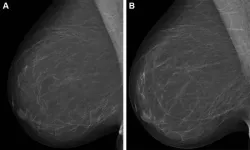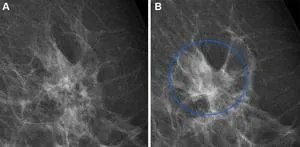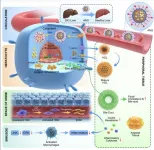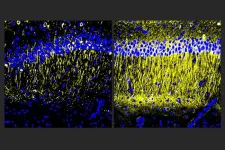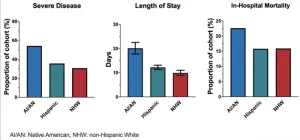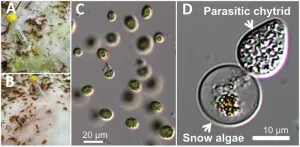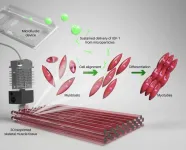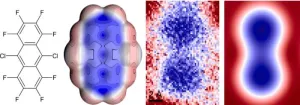(Press-News.org) OAK BROOK, Ill. – Combining artificial intelligence (AI) systems for short- and long-term breast cancer risk results in an improved cancer risk assessment, according to a study published in Radiology, a journal of the Radiological Society of North America (RSNA).
Most breast cancer screening programs take a one-size-fits-all approach and follow the same protocols when it comes to determining a woman’s lifetime risk of developing breast cancer. Using mammography-based deep learning models may improve the accuracy of breast cancer risk assessment and can also lead to earlier diagnoses.
“About 1 in 10 women develop breast cancer throughout their lifetime,” said study author Andreas D. Lauritzen, Ph.D., from the Department of Computer Science at the University of Copenhagen in Denmark. “In recent years, AI has been studied for the purpose of diagnosing breast cancer earlier by automatically detecting breast cancers in mammograms and measuring the risk of future breast cancer.”
A variety of AI tools exist to aid in detecting cancer risk. Diagnostic AI models are trained to detect suspicious lesions on mammograms and are well suited to estimate short-term breast cancer risk.
More suitable for long-term breast cancer risk are texture AI models, capable of identifying breast density. Women with dense breast tissue are at higher risk of developing breast cancer and may benefit from supplemental MRI screening.
“It is important to enable reliable and robust assessment of breast cancer risk using information from the screening mammogram,” Dr. Lauritzen said.
For this study, Dr. Lauritzen and his research team sought to identify whether a commercially available diagnostic AI tool and an AI texture model, trained separately and then subsequently combined, may improve breast cancer risk assessment.
The researchers used the diagnostic AI tool Transpara and a texture model that was developed by the researchers. A Dutch training set of over 39,000 exams was used to train the models. The short- and long-term risk models were combined using a three-layer neural network.
The combined AI model was tested on a study group of more than 119,000 women who were included in a breast cancer screening program in the Capital Region of Denmark between November 2012 and December 2015. The average age of the women was 59 years.
Compared to the diagnostic and texture models alone, the combined AI model showed an overall improved risk assessment for both interval and long-term cancer detection. Interval cancers are those that are found between routine screenings.
The model also enabled identification of women at high risk for breast cancer. Women identified by the combined model as having the 10% highest combined risk accounted for 44.1% of interval cancers and 33.7% of long-term cancers.
Using AI to identify a women’s breast cancer risk from a single mammogram will not only result in earlier cancer detection but can also improve the strain on the health care system due to the worldwide shortage of specialized breast radiologists.
“Current state-of-the-art clinical risk models require multiple tests such as blood work, genetic testing, mammogram and filling out extensive questionnaires, all of which would substantially increase the workload in the screening clinic,” Dr. Lauritzen said. “Using our model, risk can be assessed with the same performance as the clinical risk models but within seconds from screening and without introducing overhead in the clinic.”
###
“Assessing Breast Cancer Risk by Combining AI for Lesion Detection and Mammographic Texture.” Collaborating with Dr. Lauritzen were My C. von Euler-Chelpin, Ph.D., Elsebeth Lynge, Ph.D., Ilse Vejborg, Ph.D., Mads Nielsen, Ph.D., Nico Karssemeijer, Ph.D., and Martin Lillholm, Ph.D.
In 2023, Radiology is celebrating its 100th anniversary with 12 centennial issues, highlighting Radiology’s legacy of publishing exceptional and practical science to improve patient care.
Radiology is edited by Linda Moy, M.D., New York University, New York, N.Y., and owned and published by the Radiological Society of North America, Inc. (https://pubs.rsna.org/journal/radiology)
RSNA is an association of radiologists, radiation oncologists, medical physicists and related scientists promoting excellence in patient care and health care delivery through education, research and technologic innovation. The Society is based in Oak Brook, Illinois. (RSNA.org)
For patient-friendly information on breast imaging, visit RadiologyInfo.org.
END
An anti-obesity drug can be delivered selectively to the liver using a nanogel-based carrier, according to a study. Synthetic thyroid hormone mimics are promising treatments for metabolic diseases including metabolic dysfunction-associated steatohepatitis (MASH), high cholesterol, type 2 diabetes, and inflammatory liver disease; however, the molecules are not highly bioavailable or potent, which are necessary to see significant weight loss. S. Thayumanavan and colleagues designed a nanogel-based carrier with anionic moieties on the surface ...
Digital Science, a technology company serving stakeholders across the research ecosystem, is pleased to announce that Australia’s Nuclear Science and Technology Organisation (ANSTO) has chosen Symplectic Elements from Digital Science’s flagship products to advance awareness of its world-class research.
ANSTO is the home to some of Australia’s most significant national infrastructure for research. Thousands of scientists from industry and academia benefit from gaining access to ANSTO’s ...
Though drug developers have achieved some progress in treating Alzheimer’s disease with medicines that reduce amyloid-beta protein, other problems of the disease including inflammation, continue unchecked. In a new study, scientists at The Picower Institute for Learning and Memory at MIT describe a candidate drug that in human cell cultures and Alzheimer’s mouse models reduced inflammation and improved memory.
The target of the new “A11” molecule is a genetic transcription factor called PU.1. Prior research has shown that amid Alzheimer’s disease, PU.1 ...
A study of COVID-19 patients at a New Mexico hospital finds that the virus hit American Indian patients particularly hard—even though Native American patients had fewer other illnesses or conditions than non-native patients. Douglas Perkins and colleagues analyzed data on 475 patients with COVID-19 infections from the University of New Mexico Hospital. The sample was 30.7% Native American, 47% Hispanic, and 18.5% non-Hispanic White. At admission, Native American patients were younger, more likely to need ...
SAN ANTONIO — August 29, 2023 —Novel Southwest Research Institute-developed direction-finding technology has won a prestigious R&D 100 Award. R&D World Magazine has recognized SwRI’s Wideband Conformal Continuous-Slot Antenna Array as one of the 100 most significant innovations for 2023.
“Southwest Research Institute strives to uncover innovative solutions to complex problems,” said SwRI President and CEO Adam L. Hamilton, P.E. “I am very proud of the work SwRI does and pleased to know this technology, which will provide significant support to naval operations, has been recognized as one of the most important innovations ...
SAN ANTONIO (Aug. 29, 2023) – A DNA-based vaccine is very effective at protecting against COVID-19, according to a joint preclinical study by Scancell Ltd and Texas Biomedical Research Institute (Texas Biomed) recently published in the Journal of Biotechnology and Biomedicine.
Unlike the Pfizer and Moderna COVID-19 vaccines that use messenger RNA (mRNA) to cue the immune system to produce antibodies, this vaccine platform uses sections of viral DNA to achieve a similar result.
“There is always a need to develop new, or improve on existing vaccines to ensure we have effective tools to counter emerging variants,” says Texas Biomed Innovation ...
The microbial communities found in glacier and snowpack ecosystems are an essential part of cold weather environments. Chytrids, a group of fungi that include well-known frog pathogens, are often found in abundance in these ecosystems, but culturing these organisms and learning more about their lifecycle, including their relationship to the snow algae found in these environments, has proven challenging.
In a recently published paper, researchers revealed that they were able to analyze chytrid DNA from two alpine snowpack sites in Japan using single-spore PCR.
The paper was published in Frontiers in Microbiology on June 20.
“We have captured the chytrids ...
(LOS ANGELES) – August 29, 2023 - An advancement in 3D bioprinting of native-like skeletal muscle tissues has been made by scientists at the Terasaki Institute for Biomedical Innovation (TIBI). The key to the TIBI scientists’ approach lies in their specially formulated bioink, which contains microparticles engineered for sustained delivery of insulin-like growth factor-1 (IGF-1). As was shown in their recent paper in Macromolecular Bioscience, sustained delivery of IGF-1 enhances the formation of mature skeletal muscle tissue from muscle precursor cells and facilitates their structural alignment. This increases the efficiency of the regenerative process ...
Scientists from the IOCB Prague, the Institute of Physics of the Czech Academy of Sciences, and Palacký University Olomouc, have once again successfully uncovered the mysteries of the world of molecules and atoms. They have experimentally confirmed the correctness of a decades-old theory that assumed a non-uniform distribution of electron density in aromatic molecules. This phenomenon significantly affects the physicochemical properties of molecules and their interactions. This research expands the possibilities for designing new nanomaterials and is the theme of a paper that has just been published in Nature Communications.
The ...
Research Highlights:
Adults at risk for heart disease who participated in produce prescription programs for an average of six months increased their consumption of fruits and vegetables and had reduced blood pressure, body mass index and blood sugar levels.
Among adults and children, produce prescription programs also appeared to decrease food insecurity — the lack of equitable and stable availability, access, affordability and consumption of healthy foods and drinks — and improve self-reported health status.
Embargoed until 4 a.m. CT/5 a.m. ET Tuesday, August 29, 2023
DALLAS, August 29, 2023 — ...
